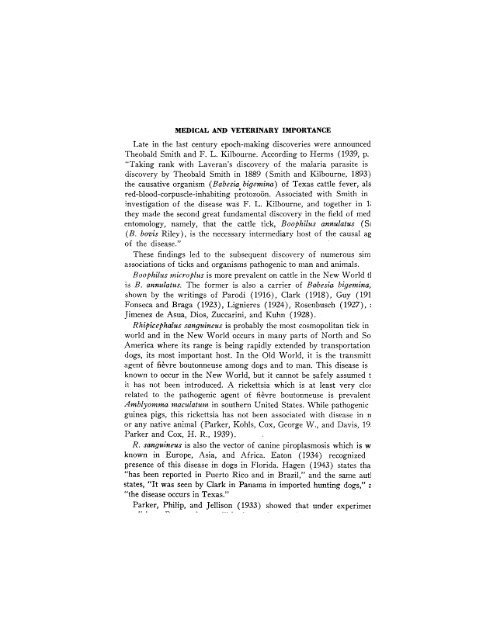The Genera Boophilus Rhipicephalus and Haemaphysalis (Ixodidae ...
The Genera Boophilus Rhipicephalus and Haemaphysalis (Ixodidae ...
The Genera Boophilus Rhipicephalus and Haemaphysalis (Ixodidae ...
You also want an ePaper? Increase the reach of your titles
YUMPU automatically turns print PDFs into web optimized ePapers that Google loves.
in the last century epoch-making discoveries were announced<br />
Late<br />
Smith <strong>and</strong> F. L. Kilbourne. According to Herms (1939, p.<br />
<strong>The</strong>obald<br />
made the second great fundamental discovery in the field of med<br />
they<br />
namely, that the cattle tick, <strong>Boophilus</strong> annulatus (S:<br />
entomology,<br />
the disease."<br />
of<br />
findings led to the subsequent discovery of numerous sire<br />
<strong>The</strong>se<br />
of ticks <strong>and</strong> organisms pathogenic to man<br />
<strong>and</strong> animals.<br />
associations<br />
microplus is more prevalent on cattle in the New World tl<br />
<strong>Boophilus</strong><br />
annulatus. <strong>The</strong> ormer is also a<br />
carrier of Babesia bigemina,<br />
is-B.<br />
by the writings of Parodi (1916), Clark (1918), Guy (191<br />
shown<br />
<strong>and</strong> Braga (1923), Lignieres (1924), Rosenbusch (1927),<br />
Fonseca<br />
de Asua, Dios, Zuccarini,.<strong>and</strong> Kuhn (1928).<br />
Jimenez<br />
sanguineus is probably the most cosmopolitan tick in<br />
<strong>Rhipicephalus</strong><br />
<strong>and</strong> in the New World occurs in many parts of North <strong>and</strong> So<br />
world<br />
where its range is being rapidly extended by transportation<br />
America<br />
its most important host. In the Old World, it is the transmitt<br />
dogs,<br />
has not been introduced. A rickettsia which is at least very clo,<br />
it<br />
to the pathogenic agent of fivre boutonneuse is prevalent<br />
related<br />
maculatum in southern United States. While pathogenic<br />
./tmblyomma<br />
pigs, this rickettsia has not been associated with disease in n<br />
guinea<br />
any native animal (Parker, Kohls, Cox, George W., <strong>and</strong> Davis, 19.<br />
or<br />
<strong>and</strong> Cox, H. R., 1939).<br />
Parker<br />
sanguineus is also the vector of canine piroplasmosis which is R. w<br />
in Europe, Asia, <strong>and</strong> Africa. Eaton (1934) recognized<br />
known<br />
of this disease in dogs in Florida' Hagen (1943)states tha<br />
presence<br />
been reported in Puerto Rico <strong>and</strong> in Brazil," <strong>and</strong> the "has aut] same<br />
"It was seen by Clark in Panama in imported hunting dogs,"<br />
states,<br />
disease occurs in Texas."<br />
"the<br />
MEDICAL AND VETERINARY IMPORTANCE<br />
rank with Laveran's discovery of the malaria parasite is<br />
'"Taking<br />
by <strong>The</strong>obald Smith in 1889 (Smith <strong>and</strong> Kilbourne, 1893)<br />
discovery<br />
the causative .organism (Babesia bigemina) of Texas cattle<br />
fever, als<br />
p'otozo6n. Associated with Smith in<br />
-red-blood-corpuscle-inhabiting<br />
of the disease was F. L. Kilbourne, <strong>and</strong> together in 11<br />
investigation<br />
(B. boris Riley), is<br />
the necessary intermediary host of the causal a<br />
of fivre boutonneuse among dogs <strong>and</strong> to man. This disease is<br />
agent<br />
to occur in the New World, but it cannot be safely.assumed<br />
known<br />
Parker, Philip, <strong>and</strong> Jellison (1933) showed that under experimet

















